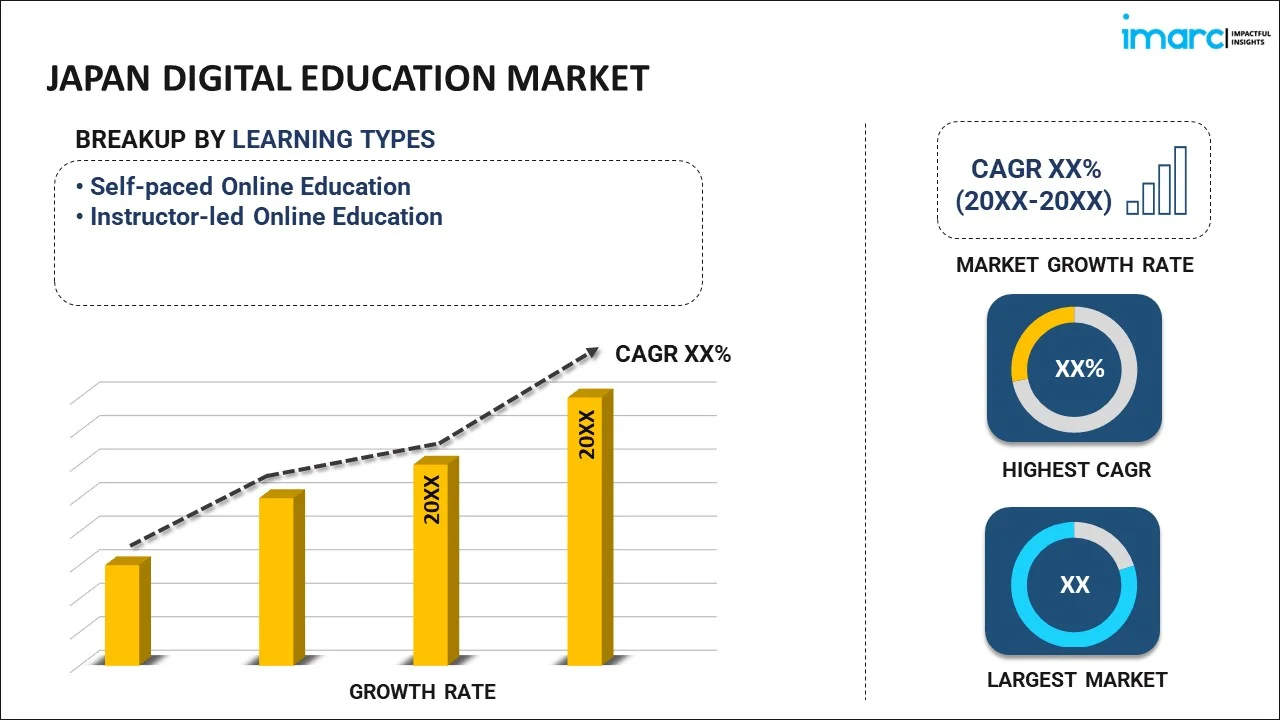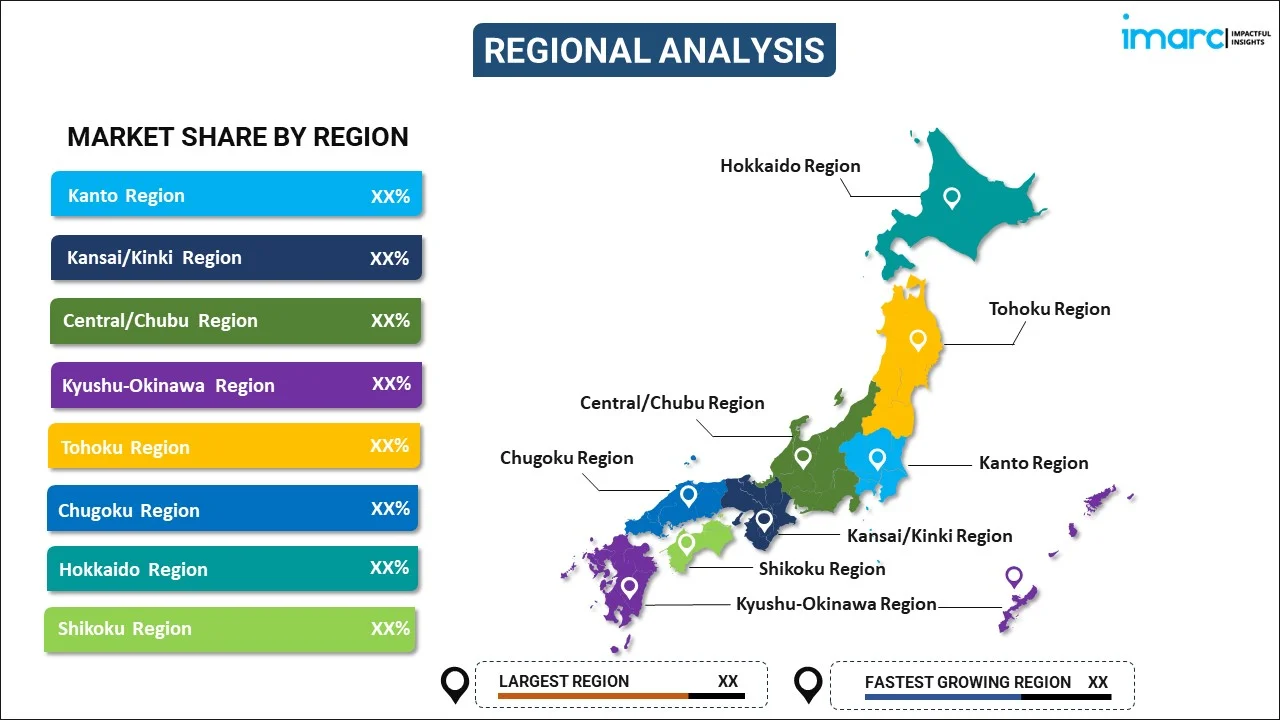
Japan Digital Education Market Report by Learning Type (Self-paced Online Education, Instructor-led Online Education), Course Type (Science, Technology, Engineering, and Mathematics (STEM), Business Management, and Others), End User (Academic Institutions and Individuals, Enterprises), and Region 2025-2033
Market Overview:
The Japan digital education market size reached USD 4.5 Billion in 2024. Looking forward, IMARC Group expects the market to reach USD 9.4 Billion by 2033, exhibiting a growth rate (CAGR) of 8.4% during 2025-2033. The recent onset of the COVID-19 pandemic led to the adoption of digital technologies, the widespread adoption of digital education in the education sector, and the implementation of government initiatives to promote digital education, represent some of the key factors driving the market.
|
Report Attribute
|
Key Statistics
|
|---|---|
|
Base Year
|
2024
|
|
Forecast Years
|
2025-2033
|
|
Historical Years
|
2019-2024
|
|
Market Size in 2024
|
USD 4.5 Billion |
|
Market Forecast in 2033
|
USD 9.4 Billion |
| Market Growth Rate 2025-2033 | 8.4% |
Digital education, also known as online education or e-learning, is a form of instruction that utilizes digital technology and the internet to deliver educational content and facilitate learning. It is gaining popularity, transforming the way individuals access and engage with educational resources, which offers numerous benefits and has the potential to transform traditional learning methods. It allows learners to access course materials and participate in classes from virtually anywhere with an internet connection, which is beneficial for individuals who may have geographical or time constraints that prevent them from attending in-person classes. Additionally, learners can choose when and where they want to study, allowing them to tailor their learning experience to their individual needs and schedules, which is beneficial for working professionals and non-traditional students who juggle several responsibilities. It also offers several content and resources and includes numerous formats, including video lectures, interactive simulations, quizzes, and discussion forums, and caters to several learning styles and preferences, enhancing the learning experience. Nowadays, digital education often incorporates advanced technologies such as artificial intelligence and machine learning to personalize learning pathways that can analyze a student's performance and adapt the content accordingly, providing targeted assistance and challenges as needed.
Japan Digital Education Market Trends:
The Japan digital education market is primarily driven by the widespread adoption of digital technologies in the education sector. These factors are transforming the way students learn and educators teach, making digital education a significant and expanding industry in Japan. Also, the recent onset of the COVID-19 pandemic accelerated the adoption of digital education in Japan with the temporary closure of schools and the need for remote learning solutions, resulting in the adoption of online platforms and digital resources by students and educators which highlighted the importance of digital education, leading to increased investments in technology infrastructure and online learning platforms. Moreover, several technological advancements and significant advancements in digital technology, including high-speed internet access, mobile devices, and cloud computing, represent another major growth-inducing factor. Besides this, the integration of digital tools and resources into classrooms makes learning more interactive and accessible, which is accelerating the market growth. Along with this, the implementation of government initiatives to promote its growth with the launch of the digital-first policy is accelerating digital transformation across various sectors, including education, thus propelling market growth. It includes funding for the development of digital content, teacher training in digital teaching methods, and the provision of digital devices to students. Apart from this, the rising demand for personalized learning experiences caters to the individual needs and preferences of students, thus contributing to market growth. Furthermore, adaptive learning platforms and artificial intelligence-powered tools can assess students' strengths and weaknesses and provide tailored content and recommendations, which is gaining popularity as it enhances learning outcomes and engagement, thus creating a positive market outlook.
Japan Digital Education Market Segmentation:
IMARC Group provides an analysis of the key trends in each segment of the market, along with forecasts at the country level for 2025-2033. Our report has categorized the market based on learning type, course type, and end user.
Learning Type Insights:

- Self-paced Online Education
- Instructor-led Online Education
The report has provided a detailed breakup and analysis of the market based on the learning type. This includes self-paced online education and instructor-led online education.
Course Type Insights:
- Science, Technology, Engineering, and Mathematics (STEM)
- Business Management
- Others
A detailed breakup and analysis of the market based on the course type have also been provided in the report. This includes science, technology, engineering, and mathematics (STEM), business management, and others.
End User Insights:
- Academic Institutions and Individuals
- Enterprises
The report has provided a detailed breakup and analysis of the market based on the end user. This includes academic institutions and individuals and enterprises.
Regional Insights:

- Kanto Region
- Kansai/Kinki Region
- Central/ Chubu Region
- Kyushu-Okinawa Region
- Tohoku Region
- Chugoku Region
- Hokkaido Region
- Shikoku Region
The report has also provided a comprehensive analysis of all the major regional markets, which include Kanto Region, Kansai/Kinki Region, Central/ Chubu Region, Kyushu-Okinawa Region, Tohoku Region, Chugoku Region, Hokkaido Region, and Shikoku Region.
Competitive Landscape:
The market research report has also provided a comprehensive analysis of the competitive landscape. Competitive analysis such as market structure, key player positioning, top winning strategies, competitive dashboard, and company evaluation quadrant has been covered in the report. Also, detailed profiles of all major companies have been provided.
Japan Digital Education Market Report Coverage:
| Report Features | Details |
|---|---|
| Base Year of the Analysis | 2024 |
| Historical Period | 2019-2024 |
| Forecast Period | 2025-2033 |
| Units | Billion USD |
| Scope of the Report | Exploration of Historical and Forecast Trends, Industry Catalysts and Challenges, Segment-Wise Historical and Predictive Market Assessment:
|
| Learning Types Covered | Self-paced Online Education, Instructor-led Online Education |
| Course Types Covered | Science, Technology, Engineering, and Mathematics (STEM), Business Management, Others |
| End Users Covered | Academic Institutions and Individuals, Enterprises |
| Regions Covered | Kanto Region, Kansai/Kinki Region, Central/ Chubu Region, Kyushu-Okinawa Region, Tohoku Region, Chugoku Region, Hokkaido Region, Shikoku Region |
| Customization Scope | 10% Free Customization |
| Post-Sale Analyst Support | 10-12 Weeks |
| Delivery Format | PDF and Excel through Email (We can also provide the editable version of the report in PPT/Word format on special request) |
Key Questions Answered in This Report:
- How has the Japan digital education market performed so far and how will it perform in the coming years?
- What has been the impact of COVID-19 on the Japan digital education market?
- What is the breakup of the Japan digital education market on the basis of learning type?
- What is the breakup of the Japan digital education market on the basis of course type?
- What is the breakup of the Japan digital education market on the basis of end user?
- What are the various stages in the value chain of the Japan digital education market?
- What are the key driving factors and challenges in the Japan digital education?
- What is the structure of the Japan digital education market and who are the key players?
- What is the degree of competition in the Japan digital education market?
Key Benefits for Stakeholders:
- IMARC’s industry report offers a comprehensive quantitative analysis of various market segments, historical and current market trends, market forecasts, and dynamics of the Japan digital education market from 2019-2033.
- The research report provides the latest information on the market drivers, challenges, and opportunities in the Japan digital education market.
- Porter's five forces analysis assist stakeholders in assessing the impact of new entrants, competitive rivalry, supplier power, buyer power, and the threat of substitution. It helps stakeholders to analyze the level of competition within the Japan digital education industry and its attractiveness.
- Competitive landscape allows stakeholders to understand their competitive environment and provides an insight into the current positions of key players in the market.
Need more help?
- Speak to our experienced analysts for insights on the current market scenarios.
- Include additional segments and countries to customize the report as per your requirement.
- Gain an unparalleled competitive advantage in your domain by understanding how to utilize the report and positively impacting your operations and revenue.
- For further assistance, please connect with our analysts.
 Inquire Before Buying
Inquire Before Buying
 Speak to an Analyst
Speak to an Analyst
 Request Brochure
Request Brochure
 Request Customization
Request Customization




.webp)




.webp)












